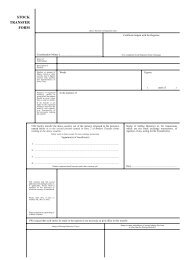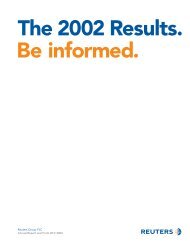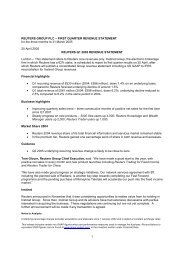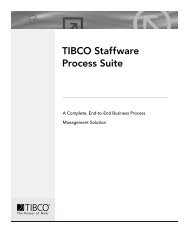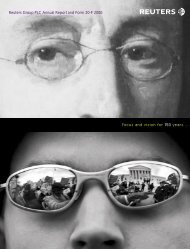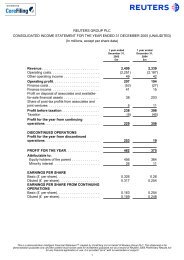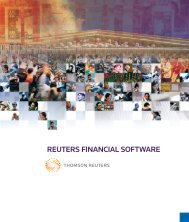The Reuters Corpus Volume 1 - from Yesterday's News to ...
The Reuters Corpus Volume 1 - from Yesterday's News to ...
The Reuters Corpus Volume 1 - from Yesterday's News to ...
- No tags were found...
Create successful ePaper yourself
Turn your PDF publications into a flip-book with our unique Google optimized e-Paper software.
<strong>The</strong> <strong>Reuters</strong> <strong>Corpus</strong> <strong>Volume</strong> 1 -<strong>from</strong> <strong>Yesterday's</strong> <strong>News</strong> <strong>to</strong> Tomorrow's Language ResourcesTony Rose, Mark Stevenson, Miles WhiteheadTechnology Innovation Group<strong>Reuters</strong> Limited, 85 Fleet Street, London EC4P 4AJ{<strong>to</strong>ny.rose, mark.stevenson, miles.whitehead}@reuters.comAbstract<strong>Reuters</strong>, the global information, news and technology group, has for the first time made available free of charge, large quantities ofarchived <strong>Reuters</strong> news s<strong>to</strong>ries for use by research communities around the world. <strong>The</strong> <strong>Reuters</strong> <strong>Corpus</strong> <strong>Volume</strong> 1 (RCV1) includes over800,000 news s<strong>to</strong>ries - typical of the annual English language news output of <strong>Reuters</strong>. This paper describes the origins of RCV1, themotivations behind its creation, and how it differs <strong>from</strong> previous corpora. In addition we discuss the system of category coding,whereby each s<strong>to</strong>ry is annotated for <strong>to</strong>pic, region and industry sec<strong>to</strong>r. We also discuss the process by which these codes were applied,and examine the issues involved in maintaining quality and consistency of coding in an operational, commercial environment.1. Introduction<strong>Reuters</strong> is a leading global provider of financialinformation, news and technology <strong>to</strong> financial institutions,the media, businesses and individuals. It is also theworld's largest international text and television newsagency, with over 2,000 journalists, pho<strong>to</strong>graphers andcamera opera<strong>to</strong>rs in 190 bureaux, serving 151 countries.On a typical day, <strong>Reuters</strong> Edi<strong>to</strong>rial produces some 11,000s<strong>to</strong>ries in 23 languages, along with approx. 600 pictures,some 23 hours of video and dozens of graphics.<strong>The</strong> <strong>Reuters</strong> <strong>Corpus</strong> <strong>Volume</strong> 1 is an archive of 806,791English language news s<strong>to</strong>ries that is freely available <strong>to</strong>the research community 1 . It includes all English languages<strong>to</strong>ries produced by <strong>Reuters</strong> journalists between 20/8/1996and 19/8/1997. <strong>The</strong> s<strong>to</strong>ries are formatted using aconsistent XML schema that is based on an early versionof <strong>News</strong>ML 2 - an open standard conceived within <strong>Reuters</strong>that has since been developed through the InternationalPress Telecommunications Council (IPTC) 3 . This presentsclear advantages for researchers, such as easier access <strong>to</strong>the content and an increased potential for the developmen<strong>to</strong>f standardized <strong>to</strong>ols for the manipulation andtransformation of the data.A key aspect of this schema is the extensive use ofdescriptive metadata, whereby all the s<strong>to</strong>ries are fullyannotated using category codes for <strong>to</strong>pic, region andindustry sec<strong>to</strong>r. This metadata represents many hours ofedi<strong>to</strong>rial effort and constitutes a unique and valuableresource, particularly <strong>to</strong> members of the machine learningcommunity. However, the value of this metadata isinevitably governed by the consistency with which it isapplied. Evidently, the coding process may never beperfectly consistent – it is difficult <strong>to</strong> produce perfectlyconsistent annotations, particularly when complex codingschemes are involved (Carletta, 1996; Carletta et. al.,1997; Cleverdon, 1991).One of the major goals of this paper is therefore <strong>to</strong>document the principles and practices used in applying1 Further details are available <strong>from</strong>http://about.reuters.com/researchandstandards/corpus/2 http://www.newsml.org3 http://www.iptc.orgcodes <strong>to</strong> each of the s<strong>to</strong>ries in RCV1. Ideally (for a groupof <strong>Reuters</strong> employees), such a process should be astraightforward exercise: you simply ask the individualswho were directly involved <strong>to</strong> describe what they did.However, in practice, things are rarely that simple:employees move on, practices change, and purposeschange (at the time the corpus data was produced few ofthose involved could have envisaged that it would besubsequently re-purposed as a text corpus for scientificresearch). Consequently, at the time of writing (March,2002), no formal specification of the coding practicesexists. However, with appropriate detective work, it ispossible <strong>to</strong> combine related documentation withinterviews of key personnel <strong>to</strong> create a cohesive, reliableaccount of the process. This paper embodies the majorresults of that investigative work 4 .2. MotivationsIn the late 1990s, <strong>Reuters</strong> coding operations weresubject <strong>to</strong> two divergent market forces. Firstly, far greaterquantities of information were becoming availablethrough a variety of channels and media. As a result ofthis 'information overload', additional manual effort wasneeded <strong>to</strong> provide richer metadata for more accuratesearch and filtering. However, competition in themarketplace meant that production costs had <strong>to</strong> becontrolled, and this required a greater degree ofau<strong>to</strong>mation in the coding process.At the time, a rule-based categorization system knownas 'TIS' (Topic Identification System) was in use.However, the rule-based approach had several drawbacks:• Creating rules required specialized knowledge,which made it difficult <strong>to</strong> add new codes or adapt<strong>to</strong> changes in the input.• <strong>The</strong> rules did not provide any indication of theconfidence in their output, so there was no way offocusing edi<strong>to</strong>rial efforts on the most uncertaincases, nor any way of indicating that new <strong>to</strong>picswere appearing in the s<strong>to</strong>ries that would requirechanges or additions <strong>to</strong> the code set.4 © <strong>Reuters</strong> 2002. All rights reserved.
<strong>The</strong>se issues and a number of operational fac<strong>to</strong>rsmitigated against the further development of TIS, and itwas becoming clear that a <strong>to</strong>tally new approach <strong>to</strong>categorization was required. It was also apparent that anynew solution would have <strong>to</strong> take in<strong>to</strong> account fac<strong>to</strong>rs suchas maintenance overheads, durability, and the ability <strong>to</strong>accommodate new <strong>to</strong>pics appearing in the data.Nonetheless, the primary concern was still the ability <strong>to</strong>apply codes accurately, and <strong>to</strong> measure this the companyneeded a collection of suitable test data.One solution, therefore, was <strong>to</strong> create a corpus ofs<strong>to</strong>ries coded <strong>to</strong> some benchmark standard. This processwould have involved pairs of edi<strong>to</strong>rs independentlyapplying codes <strong>to</strong> a common set of s<strong>to</strong>ries, and thenidentifying and discussing any inconsistencies thatemerged. An iterative process would ensure that thecoding practices eventually converged. Evidently, thisprocess happened <strong>to</strong> a certain degree as part of the edi<strong>to</strong>rs'everyday interaction, but not in such a way that any"benchmark s<strong>to</strong>ries" could be differentiated <strong>from</strong> theoverall operational output.Moreover, building a substantial benchmark corpususing this approach would have taken considerable time,and ultimately proved <strong>to</strong>o labour-intensive for anoperational environment. Nonetheless, it was clear that thecompany would benefit <strong>from</strong> having a large corpus oftraining data for future evaluations, so the construction ofthe <strong>Reuters</strong> <strong>Corpus</strong> began.3. RCV1 and previous corporaInterestingly, although RCV1 is the first "official"<strong>Reuters</strong> corpus, it is not the first time that <strong>Reuters</strong> newss<strong>to</strong>ries have been used for research. An earlier collectionof s<strong>to</strong>ries, known as the "<strong>Reuters</strong>-21578" collection, hasbeen available <strong>from</strong> a public web site for many years 5 .This corpus is an adaptation of the older “<strong>Reuters</strong>-22173”corpus that consisted of 22,173 <strong>Reuters</strong> newswire s<strong>to</strong>riesdated <strong>from</strong> 1987. <strong>Reuters</strong>-21578 has proved an extremelypopular resource and has been used in numerous studies.Indeed, it is estimated that this corpus has provided datafor over 100 published research papers, particularly in thefields of information retrieval, natural language processingand machine learning (eg. Joachims, 1998; Nigam, 1998;Yang, 1999). This is an indication of the value of suchcorpora and <strong>Reuters</strong> has since received many requests <strong>to</strong>provide further data for research purposes, but up <strong>to</strong> nowwe have generally been prevented <strong>from</strong> doing so due <strong>to</strong>legal/copyright restrictions. A further motivation behindthe new <strong>Reuters</strong> <strong>Corpus</strong> was thus <strong>to</strong> provide astandardized collection, suitable for research purposes,with the minimum possible restrictions.Despite its popularity, <strong>Reuters</strong>-21578 does have anumber of significant disadvantages, particularly that ofoverall size (only 21,578 documents). By contrast, RCV1is some 35 times larger. In addition, <strong>Reuters</strong>-21578covered only a fraction of a year, with somewhatinconsistent coverage of that time period. By contrast,RCV1 covers a complete year of edi<strong>to</strong>rial output, allowingthe investigation of temporal issues such as <strong>to</strong>pic detection& tracking (Wayne, 2000), conflict prediction (Bond et al,5 Currently available <strong>from</strong>:http://www.daviddlewis.com/resources/testcollections/reuters21578/index.html1997) or financial market forecasting (Giles et. al. 1997).In addition, RCV1 was created <strong>from</strong> a news archiveproduct (i.e. a database) rather than a raw newswire feed,which helps <strong>to</strong> ensure consistency (since there should befewer duplicates, corrections, brief alerts, etc.)However, one advantage that the older collection doespossess is that much effort has been applied in identifyingsuitable training/test splits for various applications,particularly those of text categorization and machinelearning (e.g. Lewis, 1992). Work on the new <strong>Corpus</strong> isonly just beginning in this respect, but it is hoped thatmuch of what was learned with <strong>Reuters</strong>-21578 will be ofvalue in future studies.At the time of writing, the new <strong>Corpus</strong> has beensupplied <strong>to</strong> 242 separate organisations, of which 120 areacademic institutions and 110 commercial organisations(the remainder being government organisations,individuals, etc.). <strong>The</strong>se are distributed across 40 differentcountries - with USA having the highest number ofapplicants (75) followed by the UK (43) and Germany(21). Interestingly, many of these early requests weregenerated almost entirely by word-of-mouth, before anyformal publicity or promotion had taken place. Many ofthese early applicants were TREC participants, since the<strong>Reuters</strong> <strong>Corpus</strong> was the official dataset for the 2001filtering track (Robertson and Callan, 2001).4. Coding the <strong>Reuters</strong> <strong>Corpus</strong>4.1. <strong>The</strong> Coding SchemeAll the s<strong>to</strong>ries in RCV1 have been coded for <strong>to</strong>pic,region (geography) and industry sec<strong>to</strong>r. This codingscheme was designed <strong>to</strong> enable effective retrieval <strong>from</strong>database products such as <strong>Reuters</strong> Business Briefing(RBB). <strong>The</strong> s<strong>to</strong>ries cover a range of content typical of aninternational English language newswire, and can vary<strong>from</strong> a few hundred <strong>to</strong> several thousand words in length.<strong>The</strong> data is available on two CD-ROMs and hasundergone a significant amount of verification andvalidation of the content (i.e. removal of duplicates andother spurious entries, normalisation of dateline & bylineformats, addition of copyright statements, etc.). Anexample s<strong>to</strong>ry is shown in Appendix A (with sometruncation of the metadata <strong>to</strong> conserve space).4.1.1. Topic codes<strong>The</strong> <strong>to</strong>pic codes represent the subject area(s) of theeach s<strong>to</strong>ry. <strong>The</strong>y are organized in<strong>to</strong> four hierarchicalgroups, with 4 <strong>to</strong>p-level nodes: Corporate/Industrial(CCAT), Economics (ECAT), Government/Social(GCAT) and Markets (MCAT). <strong>The</strong> code set wasdesigned originally around requirements of businessinformation professionals, although this was broadened <strong>to</strong>include the needs of end users in large corporates, banks,financial services, consultancy, marketing, advertising andPR firms.<strong>The</strong> file <strong>to</strong>pic_codes.txt on the RCV1 CD lists 126codes. However, not all of these were used in the codingof the corpus. For example, there is a set of 11 codeslabelled as 'current news', but these and the 2 codesmarked as 'temporary' are unused in the corpus data. Inaddition, a further 10 codes (G11 <strong>to</strong> G14, plus GEDU andMEUR) also appear <strong>to</strong> be unused. <strong>The</strong>refore, the <strong>to</strong>tal
number of codes actually assigned <strong>to</strong> the data is 126 - 11 -2 - 10 = 103.Under each <strong>to</strong>p-level node there is a hierarchy ofcodes, with the depth of each implied by the length of thecode. For example, the Corporate/Industrial taxonomy isstructured as follows:CCAT (Corporate/Industrial) C1 C15 ('Performance') C151 ('Accounts/Earnings') C1511 ('Annual Results')However, it should be noted that the nodes at thesingle-digit level (e.g. C1-C4, E1-E7, G1 and M1) neverexisted as operational codes, and were therefore neverassigned <strong>to</strong> the data (even though their existence isimplied by the hierarchy).When the s<strong>to</strong>ries in RCV1 were coded, the principlewas <strong>to</strong> apply the most specific (i.e. most granular) codethat was relevant in each case. However, edi<strong>to</strong>rs were free<strong>to</strong> assign any of the codes they felt appropriate (i.e. notjust leaf nodes), so in practice they sometimes applied ahigh level code if none of the more granular codes wasappropriate. In addition, there was a principle that at leas<strong>to</strong>ne <strong>to</strong>pic code and one region code should be assigned <strong>to</strong>each s<strong>to</strong>ry. However, in practice there are 2,364documents that have no <strong>to</strong>pic codes, and a further 13 thathave no region codes (a <strong>to</strong>tal of 2,377 documents, or0.29% of the entire corpus). <strong>The</strong> authors are currentlyworking with the RCV1 user community <strong>to</strong> provide anappropriate resolution for this (e.g. a script <strong>to</strong>au<strong>to</strong>matically remove them <strong>from</strong> the collection).Once each s<strong>to</strong>ry had been coded, each individual <strong>to</strong>piccode was au<strong>to</strong>matically 'expanded', such that all itsances<strong>to</strong>rs in the hierarchy would be added as well (e.g. inthe example in Appendix A the code E11 requires ECAT<strong>to</strong> be added, and M11 and M12 require MCAT <strong>to</strong> beadded).4.1.2. Industry codes<strong>The</strong> industry codes were used <strong>to</strong> indicate the differenttypes of business or industry referred <strong>to</strong> by each s<strong>to</strong>ry.<strong>The</strong>re are 870 codes listed in the file industry_codes.txt,and they are also arranged as a hierarchy, with the depthof each node implied by the length of the code. However,only the 6- or 8-character variations were intended <strong>to</strong> beassigned <strong>to</strong> s<strong>to</strong>ries, since the intermediate length codes(i.e. 2-5 characters) are simply the product of a legacyediting system. So for example, of the following codes,only the last (i.e. the 6 character version) is intended forassignment <strong>to</strong> documents:I0 AGRICULTURE, FORESTRY AND FISHINGI00 AGRICULTURE, FORESTRY AND FISHINGI000 AGRICULTURE, FORESTRY AND FISHINGI0000 AGRICULTURE, FORESTRY AND FISHINGI00000 AGRICULTURE, FORESTRY AND FISHING<strong>The</strong>re were therefore only 376 such codes intended foractual use (ignoring the codes labelled TEMPORARY orDUMMY). As with <strong>to</strong>pic codes, once each s<strong>to</strong>ry had beencoded, each individual code was au<strong>to</strong>matically 'expanded',such that all its ances<strong>to</strong>rs in the hierarchy would be addedas well. However, the RCV1 data retains only theexpansions of 8-character nodes <strong>to</strong> their 6-characterances<strong>to</strong>rs, and no further. In addition, some 6,771documents are missing even this degree of expansion (i.e.they possess an 8-character industry code but no 6-character ances<strong>to</strong>r). <strong>The</strong> authors are currently workingwith the RCV1 user community <strong>to</strong> provide an appropriateresolution for both of these issues (e.g. a script <strong>to</strong>au<strong>to</strong>matically add the missing expansions).4.1.3. Region codes<strong>The</strong> region codes are used <strong>to</strong> indicate the geographicalregions referred <strong>to</strong> in a s<strong>to</strong>ry. <strong>The</strong>y can be thought of asrepresenting three groups:• Countries (e.g. UK)• Geographical groups (e.g. BENELUX)• Economic groupings (e.g. GSEVEN)However, there is no explicit hierarchical structure <strong>to</strong>the region codes, and hence (unlike the <strong>to</strong>pic and industrycodes) no au<strong>to</strong>matic expansion was performed.<strong>The</strong>re are 366 region codes listed in the fileregion_codes.txt. However, a further 3 have been found <strong>to</strong>appear in the corpus: CZ - CANAL ZONE (1 occurrence),CZECH - CZECHOSLOVAKIA (2 occurrences) andGDR - EAST GERMANY (1 occurrence). <strong>The</strong>se codeswere erroneously assigned and should be replaced byPANA (PANAMA), CZREP (CZECH REPUBLIC) andGFR (GERMANY) respectively.4.2. <strong>The</strong> Coding ProcessDuring the years 1996 and 1997 <strong>Reuters</strong> produced jus<strong>to</strong>ver 800,000 English language news s<strong>to</strong>ries per year. <strong>The</strong>process by which these were coded involved acombination of au<strong>to</strong>-categorization, manual editing, andmanual correction. <strong>The</strong> coding team consisted of around adozen people working full time (on shifts). <strong>The</strong> details ofthe process are as follows:4.2.1. Au<strong>to</strong>-codingFirst, s<strong>to</strong>ries were passed through TIS (the rule basedcategorizer). TIS contained rules for the majority of thecodes in the code set. However, it was believed that theapplication of certain codes would be difficult <strong>to</strong> au<strong>to</strong>matecompletely - in particular, the codes 'GODD' (humaninterest) and 'GOBIT' (obituaries) were suspected as beingbeyond the capabilities of most machines. Consequently,no rules existed for these; they had <strong>to</strong> be appliedmanually.In addition <strong>to</strong> these rules, a number of simple sourceprocessingheuristics were applied that attempted <strong>to</strong> mapexisting codes (such as those applied by <strong>Reuters</strong> Edi<strong>to</strong>rialwhen the s<strong>to</strong>ry was first filed) <strong>to</strong> the equivalent codes inthe RBB codeset. For example, a s<strong>to</strong>ry with the Edi<strong>to</strong>rialcode 'SPO' (Sport) would au<strong>to</strong>matically receive the RBBcode 'GSPO'. Similarly, there were heuristics based onother document metadata, e.g. if the slug line of an articlecontained the string "BC-PRESS DIGEST" then it wouldau<strong>to</strong>matically receive the highest level General <strong>News</strong> code(GCAT).4.2.2. Manual editingAs outlined in Section 4.1.1, it was a principle of thecoding process that each s<strong>to</strong>ry should receive at least one
egion code and at least one <strong>to</strong>pic code. <strong>The</strong>refore, thenext stage after the application of TIS was <strong>to</strong> check eachs<strong>to</strong>ry <strong>to</strong> see whether it satisfied this requirement. If so, thes<strong>to</strong>ry was sent directly <strong>to</strong> a holding queue (see Section4.2.3). If not, the s<strong>to</strong>ry was sent <strong>to</strong> a human edi<strong>to</strong>r. Thisedi<strong>to</strong>r would then assign <strong>to</strong> the s<strong>to</strong>ry all codes they feltwere appropriate, ensuring that the s<strong>to</strong>ry received at leas<strong>to</strong>ne <strong>to</strong>pic code and one region code. <strong>The</strong>y were also free<strong>to</strong> delete or modify some of the au<strong>to</strong>matically assignedcodes. Once this manual editing was complete, the s<strong>to</strong>rywas sent <strong>to</strong> the holding queue for final review.4.2.3. Manual Correction in the Holding QueueEvery 6 hours the contents of holding queue werereviewed by a further edi<strong>to</strong>r, whose responsibility was <strong>to</strong>correct any outstanding coding errors. Finally, once thiswas complete and the s<strong>to</strong>ries had passed through theholding queue, they were batched up and loaded on<strong>to</strong> theRBB database in blocks.4.3. Coding StatisticsSince all s<strong>to</strong>ries passed through the holding queue, itcan be argued that every s<strong>to</strong>ry in the collection wasmanually coded, in the sense of having the au<strong>to</strong>matedcoding checked by at least one edi<strong>to</strong>r. Moreover, s<strong>to</strong>riesthat violated any coding principle (e.g. those lacking atleast one <strong>to</strong>pic code and region code) were reviewed by atleast two edi<strong>to</strong>rs, the first of whom always added orchanged at least one of the original TIS-assigned codes.This process of manual review represents a significantinvestment in the maintenance of data quality standards.In addition, further quality control procedures wereapplied, whereby each month a senior edi<strong>to</strong>r would take asample of s<strong>to</strong>ries and assesses them for quality of coding,as well as language, punctuation, spelling etc. <strong>The</strong>outcome of this process was fed back in<strong>to</strong> the system, andthe edi<strong>to</strong>rs notified of any errors.Table 1 summarizes, for the year 1997, how manys<strong>to</strong>ries were manually edited and how many weremanually corrected in the holding queue 6 . <strong>The</strong> middle lineshows that a <strong>to</strong>tal of 505,720 s<strong>to</strong>ries went straight <strong>from</strong>TIS <strong>to</strong> the holding queue (bypassing the manual editingstage), and 334,975 of these (66.2%) were subsequentlymanually corrected. By contrast, the lower line shows thata <strong>to</strong>tal of 312,140 s<strong>to</strong>ries went <strong>from</strong> TIS via manualediting <strong>to</strong> the holding queue, but only 23,289 (13.4%) ofthese were subsequently corrected. It is possible that someof this difference could be attributed <strong>to</strong> the fact that theedi<strong>to</strong>rs making manual corrections could see which s<strong>to</strong>rieshad been au<strong>to</strong>-coded and which had been manually edited,but it nonetheless provides a significant degree ofconfidence in the degree of consistency between humanedi<strong>to</strong>rs.Uncorrected CorrectedUnedited 170,745 334,975Edited 288,851 23,289Table 1: Numbers of s<strong>to</strong>ries edited and/or corrected6 Note that RCV1 contains s<strong>to</strong>ries spanning parts of 1996and 1997, so the number of s<strong>to</strong>ries in the corpus is not thesame as the number of s<strong>to</strong>ries in Table 15. Measuring inter-coder consistencyA fundamental feature of many real-worldcategorization schemes is that the definition of codes canbe inherently quite imprecise, and as such open <strong>to</strong>interpretation by the various individuals that apply them.Various studies have shown that there can be considerablevariation in inter-indexer agreement for different data sets(Bruce and Weibe, 1998; Brants, 2000; Veronis, 1998). In<strong>Reuters</strong> case, each edi<strong>to</strong>r may have a slightly differentunderstanding of the concepts <strong>to</strong> which each code refers,and this can lead <strong>to</strong> inconsistencies in their application.Clearly, it would be of great benefit if some quantitativemeasure of inter-coder consistency could be applied <strong>to</strong> theRCV1 data. Evidently, the ideal approach would be <strong>to</strong>compare each s<strong>to</strong>ry against some benchmark standard,such as that discussed in Section 2. However, even in theabsence of such a resource, it was still possible <strong>to</strong> measuretwo aspects of coding consistency, using metadata presentin the original RBB source files (i.e. a superset of the datathat eventually became RCV1).When a human edi<strong>to</strong>r opens a s<strong>to</strong>ry, the action isrecorded by adding a flag <strong>to</strong> the ‘COMPRO’ field of thefile. <strong>The</strong> first letter after the colon is used <strong>to</strong> indicate acorrection (C) or an edit (E). Thus a COMPRO fieldcontaining the data ‘ED:ETA’ indicates a s<strong>to</strong>ry that hadfirst been through TIS (by default) and was then edited byan edi<strong>to</strong>r identified by the letters TA. Likewise, an articlewith the COMPRO field ‘ED:ETA ED:CBY’ indicates as<strong>to</strong>ry initially coded by TIS, then edited by edi<strong>to</strong>r TA andsubsequently corrected in the holding queue by edi<strong>to</strong>r BY.It is assumed that the last edi<strong>to</strong>r shown (i.e. the last <strong>to</strong>make any changes) is responsible for the final coding ofany given s<strong>to</strong>ry.One approximate measure of coding consistency is <strong>to</strong>calculate how frequently an individual edi<strong>to</strong>r’s coding iscorrected. Note that in this context any change <strong>to</strong> thecoding of a s<strong>to</strong>ry counts as a correction (rather thancounting corrections on the basis of individual codes).Since edi<strong>to</strong>rs were equally likely <strong>to</strong> be first or second <strong>to</strong>see a given s<strong>to</strong>ry, the correction rate for a given edi<strong>to</strong>r canbe calculated thus:NE = Number of s<strong>to</strong>ries coded by a given edi<strong>to</strong>rNF = Number of s<strong>to</strong>ries for which a given edi<strong>to</strong>rapplies the final codingNC = Number of times an edi<strong>to</strong>r is corrected by asecond edi<strong>to</strong>r, i.e. NE – NFCorrection Rate C = (NC/NE) * 100<strong>The</strong> results are shown in Table 2, sorted by C. Notethat this data refers <strong>to</strong> the original RBB source files, i.e. asuperset of the data that eventually became RCV1. Edi<strong>to</strong>rE101 is TIS, which generally gets corrected around 77%of the time. Since TIS was never solely responsible for anarticle (i.e. every s<strong>to</strong>ry was subsequently reviewed by atleast one human edi<strong>to</strong>r), this was not considered undulyproblematic. It should also be noted that edi<strong>to</strong>r E3 and wasnot an active BIP coder, and that edi<strong>to</strong>rs E71, E73 andE91 were still undergoing training at the time and hencewere expected <strong>to</strong> have higher correction rates.Based on this data, the average correction rate formanual edi<strong>to</strong>rs is 5.16%, i.e. slightly more than 1 in 20s<strong>to</strong>ries. However, this figure is likely <strong>to</strong> be an upper bound
on the true error rates, since some coders were known <strong>to</strong>open s<strong>to</strong>ries when checking them rather than just viewingthe s<strong>to</strong>ries, which would mean that their initials would beadded <strong>to</strong> the s<strong>to</strong>ry and flagged as a correction when in factno changes <strong>to</strong>ok place.EDITOR NE NF NC CE101 806804 182782 624022 77.35E3 153 120 33 21.57E73 6384 5183 1201 18.81E91 4602 3744 858 18.64E71 13653 11995 1658 12.14E13 36605 33636 2969 8.11E4 51686 48211 3475 6.72E9 20608 19241 1367 6.63E1 47559 44721 2838 5.97E2 53811 50648 3163 5.88E7 62179 58840 3339 5.37E24 46869 44605 2264 4.83E6 45247 43086 2161 4.78E0 55030 52473 2557 4.65E15 53749 51408 2341 4.36E20 32266 30883 1383 4.29E8 43290 41440 1850 4.27E5 42154 40615 1539 3.65E11 44039 42784 1255 2.85Table 2: Correction rates for each edi<strong>to</strong>rA second measure of consistency is <strong>to</strong> compare thedistribution of codes applied by each edi<strong>to</strong>r, in order <strong>to</strong>find any evidence of systematic bias. Since all edi<strong>to</strong>rswere equally likely <strong>to</strong> code a given s<strong>to</strong>ry (i.e. they codedall types of s<strong>to</strong>ry rather than specializing in a particulararea), a simple way <strong>to</strong> measure this is <strong>to</strong> count the numberof s<strong>to</strong>ries <strong>to</strong> which a given edi<strong>to</strong>r applied the final coding(call this N), then count the number of times each codeappears on those s<strong>to</strong>ries, then divide each code count byN.Once we have calculated the frequency distributions,we can then measure the consistency between the edi<strong>to</strong>rsby comparing each edi<strong>to</strong>r against the mean of all theothers in the group. For example, if there were ten edi<strong>to</strong>rs,then E1's distribution would be compared with the averageof distributions E2 <strong>to</strong> E9, etc. Consistency may then beestimated using a simple correlation measure, whichproduces a value of +1 for perfect consistency and -1 forcomplete inconsistency (Manning and Schutze, 1999).<strong>The</strong> results are shown in Table 3, sorted by correlation.Whilst it is difficult <strong>to</strong> identify an ideal a-priori value forconsistency, the relative degrees of correlation arenonetheless revealing. <strong>The</strong> mean correlation across all 19coders is 0.986 and their standard deviation is extremelylow at 0.018. It is clear that edi<strong>to</strong>r E3, who was not anactive BIP coder, has the lowest correlation. <strong>The</strong> nextlowest is TIS (edi<strong>to</strong>r 101), although even for this thecorrelation is still within 0.95 of the group average. <strong>The</strong>third lowest is edi<strong>to</strong>r E73, who was one of thoseundergoing training at the time.However, it should be noted that the measures appliedhere remain somewhat approximate, in that they do notconsider the potentially important differences in codingthat would appear if we were <strong>to</strong> compare different edi<strong>to</strong>rs'choices for an individual s<strong>to</strong>ry. Nonetheless, it doesprovide an interesting further insight in<strong>to</strong> the consistencyof the RCV1 coding procedures.EDITOR CORRELATIONE3 0.922E101 0.955E73 0.973E9 0.985E11 0.986E15 0.989E71 0.989E91 0.989E13 0.990E1 0.992E5 0.992E8 0.992E0 0.993E20 0.993E2 0.995E7 0.996E24 0.996E4 0.997E6 0.997Table 3: Correlation rates for each edi<strong>to</strong>r6. ConclusionThis paper has described the <strong>Reuters</strong> <strong>Corpus</strong> (RCV1),and has attempted <strong>to</strong> outline some of the ways in which itrepresents an improvement over previous corpora such as<strong>Reuters</strong>-21578. We have described the RCV1 categorycodes in considerable detail, and have outlined the processby which these codes were applied <strong>to</strong> the corpus data. Inaddition, we have described the background <strong>to</strong> thecreation of RCV1 and the business motivations behind its
elease. Moreover, we have attempted <strong>to</strong> measure thedegree of inter-coder agreement of the RCV1 data, andhave presented two approximate measures that suggest ahigh degree of coding consistency.However, the approach <strong>to</strong> coding embodied in RCV1,based on TIS and manual correction, has since beensuperseded. <strong>Reuters</strong> has since moved on <strong>to</strong> adoptstatistical categorization techniques, in which the rules areinduced <strong>from</strong> large amounts of training data, and aninbuilt feedback loop is used <strong>to</strong> initiate the involvement ofhuman edi<strong>to</strong>rs and analysis <strong>to</strong>ols <strong>to</strong> decide when newtraining data or <strong>to</strong>pic codes are required.<strong>Reuters</strong> is currently considering the possibility ofreleasing other volumes of data. In particular, we hope <strong>to</strong>be able <strong>to</strong> compile a multi-lingual corpus, containing non-English language s<strong>to</strong>ries <strong>from</strong> the same period as RCV1.This would constitute a comparable corpus that wouldhopefully be of use in the development of multi-lingualapplications such as machine translation systems andcross-language information retrieval systems. In thelonger term, we plan <strong>to</strong> investigate the possibility ofproviding corpora based on non-text media, such as animage corpus or a news corpus composed of composites<strong>to</strong>ries (i.e. text and associated images). Evidently,pho<strong>to</strong>graphic images do not decrease in value in the sameway as textual news s<strong>to</strong>ries, so the commercialimplications of such an initiative are likely <strong>to</strong> besomewhat more involved. In this respect, we activelyencourage suggestions <strong>from</strong> the research communityregarding the type of corpora that would most effectivelyserve their current and future needs.7. ReferencesBond, D., Jenkins, J., Taylor, C. and Schock, K 1997.Mapping Mass Political Conflict and Civil Society: Issuesand Prospects for the Au<strong>to</strong>mated Development of EventData. Journal of Conflict Resolution, 41,4:553-579.Brants, T., 2000. Inter-annota<strong>to</strong>r Agreement for aGerman <strong>News</strong>paper <strong>Corpus</strong>. Proceedings of LanguageResources and Evaluation Conference 2000, Athens,Greece.Bruce, R. and Weibe, J., 1998. Word SenseDistinguishability and Inter-coder Agreement.Proceedings of the 3 rd Conference on Empirical Methodsin Natural Language Processing (EMNLP-98), Granada,Spain.Carletta, J., 1996. “Assessing Agreement onclassification tasks: the kappa statistic” ComputationalLinguistics 22,2:249-254.Carletta, J., Isard, A., Isard, S., Kowtko, J., Doherty-Sneddon, G., and Anderson, A., 1997. <strong>The</strong> Reliability of aDialogue Structure Coding Scheme. ComputationalLinguistics 23(1), 13-31.Cleverdon, C. 1991. <strong>The</strong> Significance of the CranfieldTests of Index Languages. Proceedings of the 14thAnnual International ACM SIGIR Conference onResearch and Development in Information Retrieval, 3-12.Giles, C., Lawrence, S. and Tsoi, A. 1997. RuleInference for Financial Prediction using Recurrent NeuralNetworks. Proceedings of the IEEE/IAFE Conference onComputational Intelligence for Financial Engineering,Piscataway, NJ.Joachims, T., 1998. Text Categorization with SupportVec<strong>to</strong>r Machines: Learning with Many Relevant Features.Proceedings of the ECML-98, 10 th European Conferenceon Machine Learning, Chemintz, Germany.Lewis, D., 1992. An evaluation of phrasal andclustered representations on a text categorization task.Proceedings of the Fifteenth Annual International ACMSIGIR Conference on Research and Development inInformation Retrieval, pages 37-50, 1992.Manning, C. and Schutze, H, 1999. Foundations ofStatistical Language Processing. MIT Press, Cambridge,MA.Nigam, K., 1998. Learning <strong>to</strong> Classify Text formLabelled and Unlabelled Documents. Proceedings ofAAAI-98, 15th Conference of the American Associationfor Artificial Intelligence, Menlo Park, CA.Roberson, S. and Callan, J., 2001. Guidelines for theTREC-2001 Filtering Track – Version 1.0http://trec.nist.gov/data/t10_filtering/T10filter_guide.htmVeronis, J., 1998. A Study of Polysemy Judgementsand inter-annota<strong>to</strong>r agreement. Programme and AdvancedPapers of the Senseval workshop, Herstmonceux Castle,England.Wayne, C. 2000. Multilingual Topic Detection andTracking: Successful Research Enabled by Corpora andEvaluation. Proceedings of Language Resources andEvaluation Conference (LREC) 2000, 1487-1494.Yang, Y., 1999. An Evaluation of StatisticalApproaches <strong>to</strong> Text Categorization. Information Retrieval,1(1/2):67-88.8. AcknowledgementsThis paper owes much <strong>to</strong> the work of Chris Harris,who performed the original analysis of the inter-coderconsistency described in Section 5.This paper has also benefited greatly <strong>from</strong> discussionswith Dave Lewis, whose unfeasibly large appetite fordetail on RCV1 never ceases <strong>to</strong> amaze us. We are alsograteful for the input and efforts of other <strong>Reuters</strong>personnel (past and present), notably Trevor Bartlett,Dave Beck, Chris Porter, Jo Rabin, Richard Willis andAndrew Young.
9. Appendix A- MEXICO: Recovery excitement brings Mexican markets <strong>to</strong> life.Recovery excitement brings Mexican markets <strong>to</strong> life.Henry TricksMEXICO CITY- Emerging evidence that Mexico's economy was back on the recovery track sent Mexican markets in<strong>to</strong>a buzz of excitement Tuesday, with s<strong>to</strong>cks closing at record highs and interest rates at 19-month lows."Mexico has been trying <strong>to</strong> stage a recovery since the beginning of this year and it's always beengetting ahead of itself in terms of fundamentals," said Matthew Hickman of Lehman Brothers in New York."Now we're at the point where the fundamentals are with us. <strong>The</strong> his<strong>to</strong>ry is now falling out ofview."That his<strong>to</strong>ry is one etched in<strong>to</strong> the minds of all inves<strong>to</strong>rs in Mexico: an economy in crisis sinceDecember 1994, a free-falling peso and stubbornly high interest rates.This week, however, second-quarter gross domestic product was reported up 7.2 percent, muchstronger than most analysts had expected. Interest rates on governent Treasury bills, or Cetes, in thesecondary market fell on Tuesday <strong>to</strong> 23.90 percent, their lowest level since Jan. 25, 1995.<strong>The</strong> s<strong>to</strong>ck market's main price index rallied 77.12 points, or 2.32 percent, <strong>to</strong> a record 3,401.79 points,with volume at a frenzied 159.89 million shares.Confounding all expectations has been the strength of the peso, which ended higher in its longer-termcontracts on Tuesday despite the secondary Cetes drop and expectations of lower benchmark rates inTuesday's weekly auction.With U.S. long-term interest rates expected <strong>to</strong> remain steady after the Federal Reserve refrained <strong>from</strong>raising short-term rates on Tuesday, the attraction of Mexico, analysts say, is that it offers robust returns forforeigners and growing confidence that they will not fall victim <strong>to</strong> a crumbling peso."<strong>The</strong> focus is back on Mexican fundamentals," said Lars Schonander, head of researcher atSantander in Mexico City. "You have a continuing decline in inflation, a stronger-than-expected GDP growthfigure and the lack of any upward move in U.S. rates."Other fac<strong>to</strong>rs were also at play, said Felix Boni, head of research at James Capel in Mexico City,such as positive technicals and economic uncertainty in Argentina, which has put it and neighbouring Brazil'smarkets at risk."<strong>The</strong>re's a movement out of South American markets in<strong>to</strong> Mexico," he said. But Boni was also wary ofwhat he said could be "a lot of hype."<strong>The</strong> economic recovery was still export-led, and evidence was patchy that the domestic consumerwas back with a vengeance. Also, corporate earnings need <strong>to</strong> grow strongly <strong>to</strong> justify the run-up in the s<strong>to</strong>ckmarket, he said.(c) <strong>Reuters</strong> Limited 1996- - + - + + + + +



